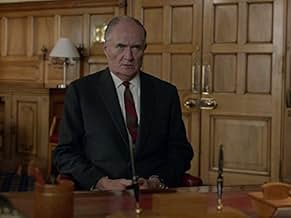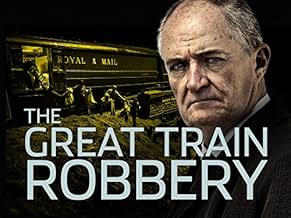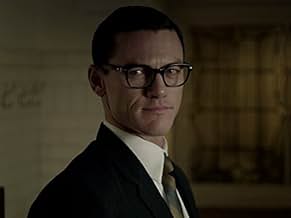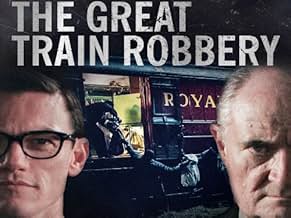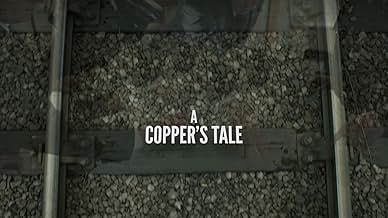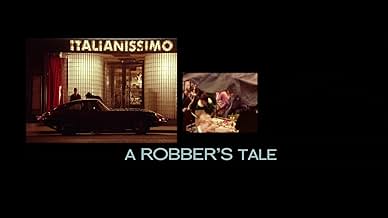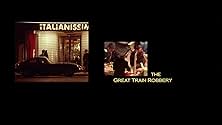NOTE IMDb
7,3/10
5,3 k
MA NOTE
Ajouter une intrigue dans votre langueA two-part drama which portrays The Great Train Robbery of 8 August 1963, firstly from the point of view of the robbers and then from the point of view of the police who set out to identify ... Tout lireA two-part drama which portrays The Great Train Robbery of 8 August 1963, firstly from the point of view of the robbers and then from the point of view of the police who set out to identify and catch the robbers.A two-part drama which portrays The Great Train Robbery of 8 August 1963, firstly from the point of view of the robbers and then from the point of view of the police who set out to identify and catch the robbers.
- Nomination aux 1 BAFTA Award
- 4 nominations au total
Parcourir les épisodes
Avis à la une
Broadcast in two parts - "The Robber's Tale" and "The Copper's Tale" - THE GREAT TRAIN ROBBERY retells the famous events of August 1963 when over £2m. was stolen from a mail train traveling from Glasgow to London. The events have been extensively retold elsewhere, notably in Peter Yates' fictionalized version ROBBERY (1967) with Stanley Baker, or BUSTER (1988) a comedy-drama with Phil Collins as robber Buster Edwards. "The Robber's Tale" (dir. Julian Jarrold) focuses specifically on Bruce Reynolds (Luke Evans) as the brains behind the whole operation; the more celebrated crook Ronald Biggs (Jack Gordon) - who passed away the night the program received its first broadcast - receives scant attention. "The Copper's Tale" looks at the painstaking ways in which Tommy Butler (Jim Broadbent) went about investigating the case and bringing the criminals to justice. Stylistically speaking the production is very much in keeping with current British television costume dramas, with low-key, almost washed-out lighting, lots of period detail (for example, the obligatory London bus from the mid-Sixties) passing across the back of the frame, or a couple of young mothers pushing their prams round the park) and plenty of focus on character through shot/reverse shot sequences. The style is diffuse, with the emphasis placed on ambiance as much as plot. "The Robber's Tale" actually proves something of a disappointment; not a lot happens in terms of action, while some of the (predominantly youthful) cast simply do not seem convincing as mid- Sixties London hoodlums. Perhaps they might have done more research into the behavior, mannerisms and (most significantly) the argot of that period. "The Copper's Tale" is a lot better, not least because of the interplay - or should that be rivalry - between Butler and his immediate subordinate Frank Williams (Robert Glenister). Although ostensibly on the same side, they seem unable to form a united front, at least professionally. Butler might be a good cop, but he certainly lacks any management abilities.
"The Great Train Robbery" is a miniseries in two parts. The first part focuses on mid-range crooks, led by Bruce Reynolds (Luke Evans) who decide to rob a train carrying a fortune in money. The second is about the police investigation and search for them.
I really enjoyed the first part, but the second part for me was a let- down. The criminals were more interesting than the police, led by DI Frank Williams (Robert Glenister) for some reason. And I sort of wanted them to get away with it. I'm sure that sounds terrible.
The acting is very good, and since it's based on a true story, it was interesting to see how the police picked up the trail of the crooks and to read at the end what happened to them.
I do recommend it, but you'll find the second part less compelling.
I really enjoyed the first part, but the second part for me was a let- down. The criminals were more interesting than the police, led by DI Frank Williams (Robert Glenister) for some reason. And I sort of wanted them to get away with it. I'm sure that sounds terrible.
The acting is very good, and since it's based on a true story, it was interesting to see how the police picked up the trail of the crooks and to read at the end what happened to them.
I do recommend it, but you'll find the second part less compelling.
In 1963, 75 km (46 miles) north of London, about 17 blokes pinched a train with a coach containing millions of pounds of cash being transported via Her Majesty's Royal Mail. It was the biggest heist in British history in which the perpetrators lifted about £2.6 million (about £50 million in today's money or $80 million). Because of the amount of money which was taken from the British government instead of a private party, an all-out investigation ensued. Eventually, about 2/3rds of the members were arrested and sent to prison. Since the heist many films and references to the heist have appeared in popular culture, including a line in the Beatles' film "Help" in which Lennon asks a Scotland Yard detective how the heist investigation is coming.
The current film, a made-for-television miniseries in 2013, is probably the best screen adaption of the heist, presenting the events in two parts. The first is from the point-of-view of the criminals, called "A Robber's Tale", and the second from the view of the investigators called "A Copper's Tale". Both segments are equally compelling with outstanding actors showing us how the crime is viewed from different sides of the railroad tracks, so to speak. Two sets of casts are used for each segment, until the very end of the second segment in which characters from both segments begin interacting.
Bruce Reynolds (Luke Evans) is the mastermind and leader of the heist. Their first large job, an airport heist in 1962, yields not nearly as much in cash as they had hoped, around £65,000 (about £1.25 million or $2 million today, which seems like a lot of money!). They were hoping for a bigger payoff. Through a tip, they discover a train bound for London from Glasgow, Scotland, contains a coach designated as Her Majesty's Royal Mail. In addition to the typical mail, the car also contains sacks of cash, pound notes probably being taken out of circulation. Reynolds resolves to pilfer the sacks of cash and puts together a team to engage the heist, including someone who claims he can stop trains. They find an old abandoned farm as a temporary hideout. As events play out, the teams hits unexpected twists in their plan, including the amount of money which turns out, like the airport heist, not to be what was expected...
The second part then chronicles the investigation and eventual arrests of members of the heist gang. Tommy Butler (Jim Broadbent) leads the Scotland Yard investigation. Butler is not only shrewd but uncompromising. He decides the best means for a successful apprehension of the criminals is to keep information close to his chest as his second-in-command Frank Williams (Robert Glenister) points out. He also forces his team to work long hours with little rest. Then the upper echelons of Scotland Yard, probably due to pressure from members of Parliament, decide to release the names and photos of the known perpetrators to the public, much to the objections of Butler and Williams. The releasing of information, as Butler and Williams predicts, leads to disastrous results, further compromising the investigation.
A very enjoyable and well-acted series. Evans makes a good Reynolds, who is not exactly a ruthless criminal but definitely uses rationalization to justify the heist. Broadbent makes a fine Butler, whose aloofness may compromise the success of the investigation. He's tempered by Robert Glenister as Frank Williams who seems the primary voice of reason during the investigation. If you like heist films, this is a real one, and it demonstrates these crimes as not nearly as easy to pull off as you would imagine if you've seen "Ocean's 11".
The current film, a made-for-television miniseries in 2013, is probably the best screen adaption of the heist, presenting the events in two parts. The first is from the point-of-view of the criminals, called "A Robber's Tale", and the second from the view of the investigators called "A Copper's Tale". Both segments are equally compelling with outstanding actors showing us how the crime is viewed from different sides of the railroad tracks, so to speak. Two sets of casts are used for each segment, until the very end of the second segment in which characters from both segments begin interacting.
Bruce Reynolds (Luke Evans) is the mastermind and leader of the heist. Their first large job, an airport heist in 1962, yields not nearly as much in cash as they had hoped, around £65,000 (about £1.25 million or $2 million today, which seems like a lot of money!). They were hoping for a bigger payoff. Through a tip, they discover a train bound for London from Glasgow, Scotland, contains a coach designated as Her Majesty's Royal Mail. In addition to the typical mail, the car also contains sacks of cash, pound notes probably being taken out of circulation. Reynolds resolves to pilfer the sacks of cash and puts together a team to engage the heist, including someone who claims he can stop trains. They find an old abandoned farm as a temporary hideout. As events play out, the teams hits unexpected twists in their plan, including the amount of money which turns out, like the airport heist, not to be what was expected...
The second part then chronicles the investigation and eventual arrests of members of the heist gang. Tommy Butler (Jim Broadbent) leads the Scotland Yard investigation. Butler is not only shrewd but uncompromising. He decides the best means for a successful apprehension of the criminals is to keep information close to his chest as his second-in-command Frank Williams (Robert Glenister) points out. He also forces his team to work long hours with little rest. Then the upper echelons of Scotland Yard, probably due to pressure from members of Parliament, decide to release the names and photos of the known perpetrators to the public, much to the objections of Butler and Williams. The releasing of information, as Butler and Williams predicts, leads to disastrous results, further compromising the investigation.
A very enjoyable and well-acted series. Evans makes a good Reynolds, who is not exactly a ruthless criminal but definitely uses rationalization to justify the heist. Broadbent makes a fine Butler, whose aloofness may compromise the success of the investigation. He's tempered by Robert Glenister as Frank Williams who seems the primary voice of reason during the investigation. If you like heist films, this is a real one, and it demonstrates these crimes as not nearly as easy to pull off as you would imagine if you've seen "Ocean's 11".
I managed to watch this on Amazon prime.
It's nothing to get overly excited about. The over the top cockney accents can get a bit annoying at times. And the acting from some is a bit wooden. But all that being said I did still really enjoy this. You just have to go in to it with the right attitude. Still well worth a watch if you are looking for something easy to follow to kill a few hours. Enjoy.
It's nothing to get overly excited about. The over the top cockney accents can get a bit annoying at times. And the acting from some is a bit wooden. But all that being said I did still really enjoy this. You just have to go in to it with the right attitude. Still well worth a watch if you are looking for something easy to follow to kill a few hours. Enjoy.
Since the story based on real events is known, I expect the film to be a little more than a purely chronological sequence of the plot. In addition to Luke Evans, the actors are not very prominent and join the monotone pattern. The film could have been more, but in the end it is a boring TV production in my eyes. And after all two long
Le saviez-vous
- AnecdotesRonald Biggs, one of the last surviving Great Train Robbers, died on 18 December 2013, the same day that this two-part series was first shown.
- GaffesPolice Officers are shown wearing white shirts. In 1963 Constables and Sergeants in all English police forces wore blue shirts. The change to white shirts came in the late 1970s.
- ConnexionsReferences La grande attaque du train d'or (1978)
Meilleurs choix
Connectez-vous pour évaluer et suivre la liste de favoris afin de recevoir des recommandations personnalisées
- How many seasons does The Great Train Robbery have?Alimenté par Alexa
Détails
- Date de sortie
- Pays d’origine
- Site officiel
- Langue
- Aussi connu sous le nom de
- 火車大劫案
- Lieux de tournage
- Sociétés de production
- Voir plus de crédits d'entreprise sur IMDbPro
- Durée1 heure 30 minutes
- Couleur
Contribuer à cette page
Suggérer une modification ou ajouter du contenu manquant

Lacune principale
What is the French language plot outline for The Great Train Robbery (2013)?
Répondre


